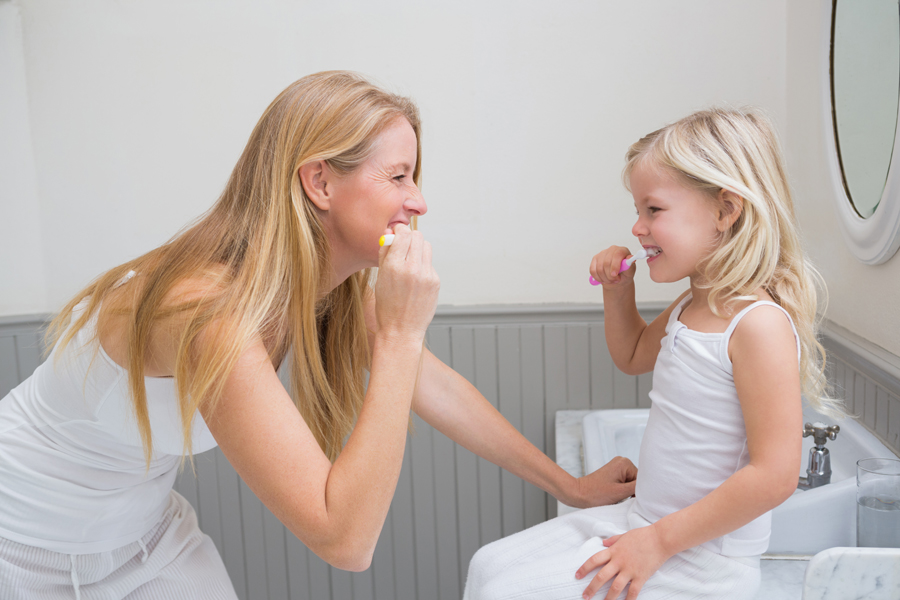Getting your child to brush their teeth is like, well, pulling teeth. They’re either too tired or too busy to bother brushing them properly. But it’s important that your child learn how to brush their teeth well so that they set themselves up for excellent oral hygiene as they get older. Here’s how your child should really be brushing their teeth, according to pediatric dentists.
When it comes to brushing their teeth, you definitely don’t want your kids to brush off this super important oral hygiene skill. Sadly, cavities count as one of the most common chronic childhood diseases, the Centers for Disease Control and Prevention reported. And it’s estimated that 1 in 5 children between the ages of 5 to 11 have at least one untreated decayed tooth. “Good home care is the cornerstone of good oral health,” says Dr. Daniel Rodda, DDS, a dentist and owner of Oasis Dental Care in Flagstaff, AZ. “Most problems that need to be fixed, such as cavities and gum disease, can be prevented with brushing and flossing.”
That’s why your child needs the basic know-how to brush their teeth well. Brush up on your own brushing skills with these tips.
Brush At Least Twice Daily
No matter what your child’s age is, they should be brushing their teeth twice a day. “We find the best results when parents incorporate this into a daily routine. Kids respond best with structure,” says Dr. Jason Hui, DDS, FAGD, a dentist and owner of Paragon Dentistry in Allen, TX. “For morning routines, we recommend implementing brushing along with getting dressed, and for evening routines to brush before bedtime.” Two minutes twice a day will help your child remove plaque and keep their teeth clean. If your child that is high in sugar or eats a lot of carbs (even fruit), you might want to brush a third time sometime during the day.
Know When Kids Can Brush On Their Own
Sure, you should start your child brushing their teeth as early as possible, but you need to know when they can actually do it on their own. “Until your child can legibly write their name, always help them brush afterward to make sure all teeth are plaque free,” advises Dr. Summer Holloway, DMD, a dentist and owner of Floss Dental Boutique in Reno, NV. “Remember, you don’t want to solely brush for them as they need to build their hygiene dexterity.”
Check Their Brushing Skills
Even if your child has been brushing their teeth for two minutes, that doesn’t mean that they brushed them well. They might have missed important areas, that, over time, can become a cavity. “A great way to ensure your child is not missing any areas after brushing is by using a GUM red-cote disclosing tablets,” says Dr. Holloway. Have your child brush like normal, and then chew the tablet, spit out the excess, and rinse twice. Anywhere that plaque remains will be tinted pink. “Most common areas kids miss when brushing are along the gum line, the cheek side of their upper molars, and the tongue side of their lower molars,” says Dr. Holloway.
Make It Mechanical
To help entice your child to brush, you can buy them a mechanical toothbrush. “Mechanical toothbrushes can be very advantageous for kids,” says Dr. Holloway. “Many of them have built in 1-2-minute timers with songs that make it fun with an end in sight.” But if your child has a manual toothbrush, you can still play a fun song on your phone while they brush to make it more interesting.
Use Fluoride Toothpaste
Depending on your child’s age, make sure that their toothpaste contains fluoride. “Fluoride will help to harden and re-mineralize the teeth,” says Dr. Rodda. But if you thought that you should slather it onto the toothbrush, think again. Although it can help in cavity protection, it’s best used in small doses. “The correct amount to use should be less than a pea size,” says Dr. Hui. “You may want to consider using a non-fluoridated toothpaste if your child is unable to spit or has a tendency to swallow the toothpaste.”
Make It Fun
One of the main reasons kids complain about brushing their teeth is because they think it’s boring. And while it might be challenging to get your kid excited about cavity prevention, there are ways to up the fun factor. “Print out a calendar for the month, which is a good amount of time to solidify a new habit,” advises Dr. Rodda. “Your child can earn a sticker for each day of brushing and flossing.” And if they complete the month with an excellent oral score, they can get a prize. Says Dr. Rodda: “Once habits are ingrained and routine, they’re more likely to be followed regularly.”
Fit In Flossing
If you thought that getting your kid to brush their teeth was tricky, try flossing. For some reason, flossing can freak out some kids, which is why you might want to slowly incorporate it into your child’s daily brushing routine. “Use floss picks and floss between the teeth 1-2 at a time, keep adding teeth each day if your child does not fight,” says Dr. Hui. “If you try to floss all the teeth at once, your child can develop a fear of the floss every-time they see it.” That’s why it’s best to start slowly and add a few teeth each day until your child feels fine about flossing. And even if your child has large spaces between their teeth, they should still get in the habit of flossing now—and it hopefully won’t be a fight later on.
Teaching your child how to brush their teeth early can help them learn healthy habits that will protect their adult teeth, too.



